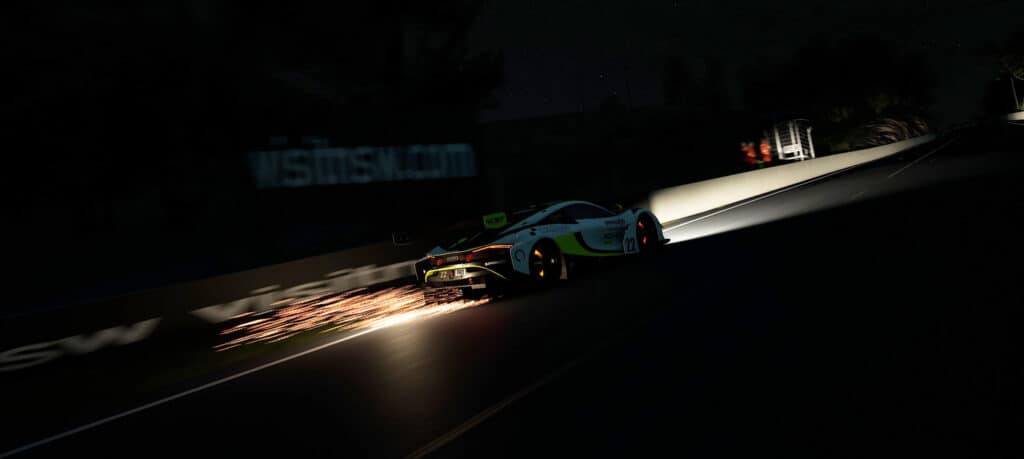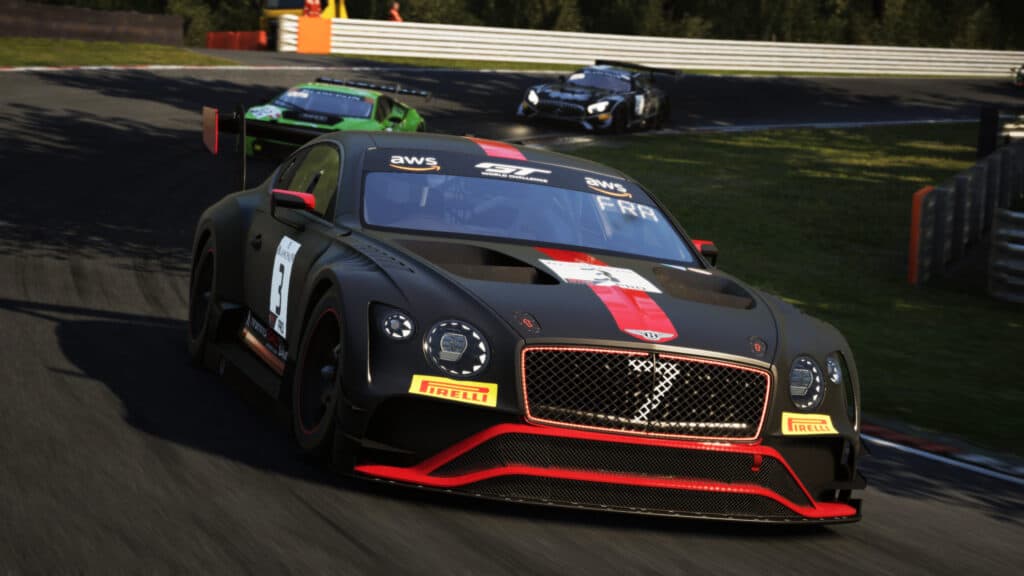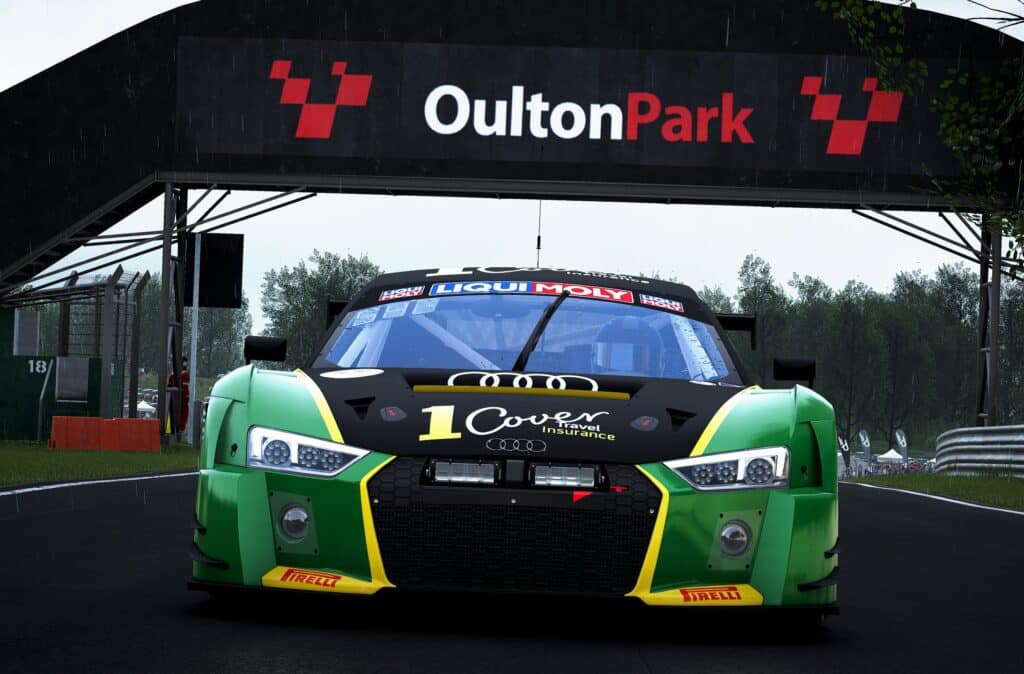Being an accurate simulation, Assetto Corsa Competizione (ACC) features all the teams, drivers and manufacturers of the real-life GT World Challenge series. This includes a diverse group of cars from manufacturers such as Aston Martin, Audi, Bentley, BMW, Ferrari, Honda, Jaguar, Lamborghini, Lexus, McLaren, Mercedes, Nissan and Porsche.
SRO Motorsports Group – the organisers of the championship – aim to balance the performance (BoP) of the manufacturers in the series to make the racing as equal and diverse as possible. This has proven to be extremely successful and led to the surge in popularity for GT3 racing worldwide.
However, there are still some key differences inherent in the characteristics of each car model, so some cars are better in the wet, some are better on their tyres, some have excellent top speed, and some are terrific over kerbs.
Here then, I hope to describe and explain some of the key differences the cars in ACC have, and show that although the BoP exists to equalise the cars, there are still noticeable discrepancies at certain tracks. It should also be noted, that the BoP is updated on a regular basis.

Front-Engine vs Mid-Engine
The GT3 cars in ACC are split into two camps – cars that are front-engined, and cars that are mid-engined. All are rear-wheel drive.
Generally, all the GT3 race cars are based on road-going equivalents featuring around 600 horsepower with all the electronic gizmos the average supercar driver – most likely a balding middle-aged man – could ever need to keep their car on the road and out of the trees.
However, the road-going variants are vastly different in their aims and execution, and some of this DNA invariably has passed through into the GT3 versions, and into ACC. For example, a Bentley Continental is a massive, motorway-cruising machine designed to eat miles at silly speeds in luxuriant style. A McLaren 720S on the other hand – although still a capable mile-muncher itself – is a hardcore supercar that would simply embarrass the Bentley in a head-to-head race on track.
Due to BoP, however, the GT3 versions are much closer, so the McLaren is essentially detuned to make it competitive with the Bentley.
The handling characteristics from the real-life road and GT3 cars also transfer to ACC. Therefore, mid-engined cars tend to understeer less than front-engined cars but are generally inferior in terms of wet-handling characteristics, where the stability of an engine over the front wheels reigns (rains?) supreme. Other mid-engined cars such as the Lamborghini Huracan, Ferrari 488 and Audi R8 tend to be less stable over kerbs than front-engined cars such as the Lexus, Mercedes and Aston Martin, and take a lot more setup work to kerb-hopping tolerable.
For example, I took part in a recent driver-swap event with Traxion’s very own John Munro in the McLaren 720S GT3 at Zolder. Throughout practise we struggled to get a handle on how to get the car safely through the horrible first chicane (the one with huge kerbs), and just couldn’t make the car fly through as effortlessly as the BMWs, Bentleys or Lexii could.
In the end, I devised a safe method of negotiating the chicane without spinning. I lost a couple of tenths per lap and kept the car out of trouble, but it left me vulnerable to attack from front-engined cars as they could monster the kerbs and carry so much more speed.

Which Car is Best in Assetto Corsa Competizione?
From the previous example you can tell that certain cars work well at certain tracks, and vice-versa. However, there are some car and track combinations that are ridiculously good in Assetto Corsa Competizione.
For example, the BoP for the Honda NSX at Mount Panorama – as well as the other Intercontinental GT Pack tracks – is very favourable. This is odd in a way, as the Honda isn’t anywhere near as good on the European circuits.
Silverstone was a track where the McLaren 720S was traditionally the quickest, but its advantage has been slashed in recent updates, but it’s still a car that is streets ahead of most of the competition at the Northamptonshire venue.
Another car that enjoys a BoP advantage is the Audi R8, which is unbelievably quick at Spa, although it does suffer from a bit of snap oversteer which isn’t ideal through Eau Rouge/Radillon.
In earlier builds of ACC, the Porsche was the king of cars and was superior at most tracks. However, its dominance has been curtailed recently with tweaked BoP, and with every update, the cars feel a lot more balanced. Hopefully, this trend continues.

It’s Not the Jaguar…
Although there are cars that have clear advantages at certain tracks, there are also cars that are good performers across a range of circuits. Generally, it’s safe to say that the Mercedes AMG GT3 Evo and Ferrari 488 GT3 Evo are cars that work well across the board, providing above-average lap times at most venues, making them excellent choices for full championship seasons.
The Bentley is also a good choice for a series of races – especially endurance races – as it has the largest fuel tank and one of the lowest fuel usage rates of any car in the sim. This means it can run longer stints than other cars, thus maximising time out on track and minimising pit stops (although most championships have a minimum driver stint time to negate this effect, the Bentley can run less fuel and therefore run lighter due to its frugal fuel use).

It would be fair to say that trying to equalise the performance between a Bentley Continental and a McLaren 720S is difficult. However, I feel that the developers of ACC – KUNOS Simulazioni – can do more to eliminate the big disparity in performance between the cars to make for more diverse grids, although it has implemented tweaks to the BOP with every update.
For example, I race in an endurance championship where driver stint times are limited to a maximum of 75 minutes. Therefore, a large percentage of the grid chose to drive the AMR Vantage GT3 due to its excellent fuel efficiency coupled with a large fuel tank (much like the Bentley). It’s also reasonably quick at most tracks – wet or dry. And with its fuel advantage drivers can push hard for a whole stint without worrying about the tank running dry.
On the other hand, the McLaren 720S & Mercedes AMG (among others) will need to either fuel save or pit earlier, putting them at a massive disadvantage in the longer endurance races.
Above all though, if you enjoy driving a certain car in ACC then just go for it, as it’s far too easy to get bogged down in the technicalities of GT3 racing. Much like the road-going equivalents, thrashing a Bentley Continental or Ferrari 488 is still a load of fun!





















